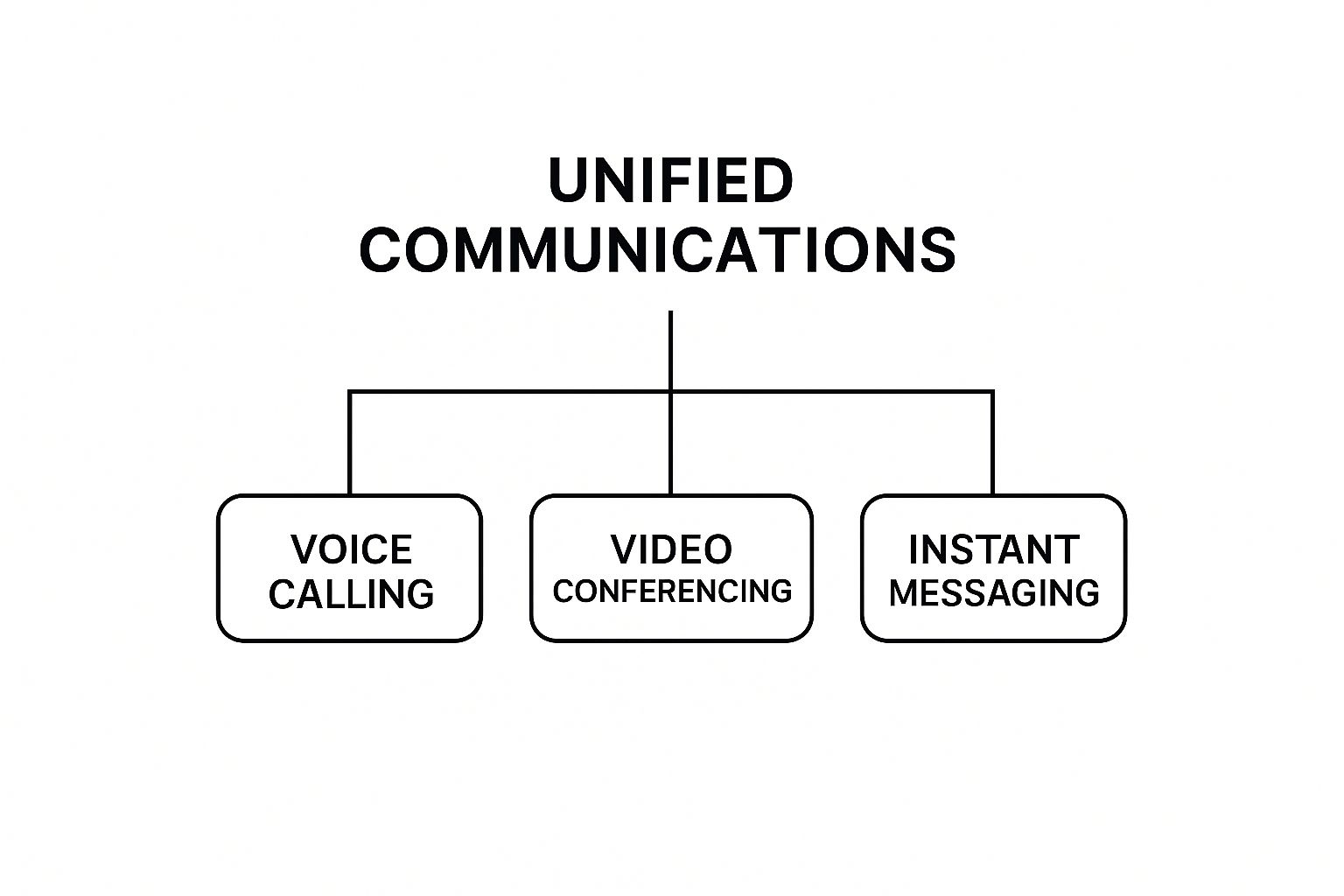Picture this: all of your business communication tools—every phone call, video meeting, instant message, and team chat—finally working together as one cohesive system. That’s the simple, powerful idea behind Unified Communications (UC). It brings every interaction into a single, intuitive platform, getting rid of the constant, frustrating shuffle between different apps.
What Is Unified Communications Simply Explained

Think of Unified Communications as the central nervous system for your company’s conversations. Instead of having one app for your phone system, another for video calls, and a third for team chats, UC merges them into a single, easy-to-use environment. This integration is the secret sauce that makes UC so valuable.
The whole point is to tear down the walls between your communication channels. For instance, a quick chat that starts as an instant message can instantly become a video call with a single click. No more fumbling around to open a separate program or emailing a new meeting link. It’s this fluid movement between tools that truly defines a UC system.
Unified Communications isn’t just about having a bunch of different tools; it’s about making those tools talk to each other so smoothly that they create a single, powerful conversation flow.
From Juggling Apps to Streamlined Workflows
Let’s be honest, in most businesses without UC, communication is a mess. An employee gets a voicemail, then has to jump over to a chat app for a follow-up message, and finally has to dig through their email to find a related document. This constant app-switching is a productivity killer that wastes time and opens the door for critical details to get lost.
A UC platform cleans all that up by giving everyone a single pane of glass. Everything you need is right there. This creates a much more natural and efficient workflow, which is an absolute game-changer for today’s hybrid and remote teams. The goal is simple: make communication so effortless that your team can focus on their actual work, not the tools they have to wrestle with to get it done.
How Unified Communications Consolidates Your Tools
So, how does this actually work in practice? The table below breaks down how a UC platform takes a scattered collection of standalone apps and rolls them into one powerful, integrated system. It’s a perfect illustration of the shift from fragmented tools to a truly unified hub.
| Core UC Function | What It Does | Standalone Tool It Replaces |
|---|---|---|
| VoIP Telephony | Lets you make and take calls over the internet from any device. | Traditional desk phones, separate softphone apps. |
| Video Conferencing | Hosts face-to-face virtual meetings with screen sharing. | Standalone video software like Zoom or Microsoft Teams. |
| Instant Messaging | Enables real-time text chat for quick questions and updates. | Separate chat apps like Slack or Google Chat. |
| Presence | Shows whether a user is available, busy, or in a meeting. | Manually updating statuses or just guessing. |
As you can see, each function is designed to absorb a task that once required its own separate application. By bringing these core capabilities together, UC eliminates clutter and creates a single source of truth for all your business communications.
Exploring the Pillars of Unified Communications
So, what really makes up a unified communications system? It’s best to think of it not as one single thing, but as a tightly integrated team of communication tools. Each “pillar” handles a specific job, but they all talk to each other and operate from one central hub.
This setup gets rid of the constant friction of jumping between different, disconnected apps. The end result is a smooth, natural flow where you can switch from a chat to a video call with a single click.
This image breaks down how all the key pieces fit together under the UC umbrella.

As you can see, distinct functions like voice and messaging are all brought into one cohesive system. Let’s take a closer look at each of these pillars and the specific business problems they’re built to solve.
Voice and VoIP Telephony
For most businesses, the bedrock of their communication system is VoIP (Voice over Internet Protocol). This technology essentially turns your internet connection into a modern, flexible phone system, cutting the cord from old-school landlines. Your team is no longer chained to a desk phone; they can make and take calls from their laptops, smartphones, or dedicated VoIP handsets.
This is the pillar that solves the problem of expensive, rigid phone contracts and gives your team the freedom to stay connected no matter where they are. Of course, a solid network is essential to make this work well. If you’re exploring flexible network options, learning about how Network-as-a-Service can provide a reliable backbone for high-quality VoIP is a great next step.
Video Conferencing
With so many teams working in hybrid or fully remote setups, video conferencing has gone from a nice-to-have to an absolute necessity. It allows for genuine face-to-face collaboration across any distance, helping to recreate that “in the same room” feeling. It’s about more than just virtual meetings; it’s a tool for building stronger team bonds and communicating with greater clarity.
Modern UC platforms don’t just stop at video. They pack in powerful features like:
- Screen Sharing: Perfect for walking someone through a process or collaborating on a document in real-time.
- Virtual Whiteboards: A digital space to brainstorm, sketch out ideas, and map out strategies together.
- Meeting Recordings: Automatically captures and transcribes meetings, creating a searchable library for anyone who missed it.
Instant Messaging and Presence
When you just need a quick answer, email is often too slow. Instant messaging (IM) is the solution, providing a space for immediate, text-based conversations that speed up decisions and keep your inbox clean.
Paired with messaging is presence, a simple but incredibly effective feature that shows you the real-time status of your colleagues. A quick glance tells you if someone is ‘Available,’ ‘In a Meeting,’ or ‘Away,’ taking all the guesswork out of reaching them.
Together, these features solve the classic “is now a good time?” dilemma, leading to smarter and less disruptive communication. The foundational elements of UC are constantly evolving, with many solutions now integrating AI co-pilots across platforms like Zendesk, Salesforce, and Slack to boost productivity and service quality. These pillars are the building blocks for creating smarter, more intuitive communication workflows.
The Real Business Impact of Unified Communications

It’s easy to get lost in the technical details of unified communications, but what really matters is the bottom-line impact. Beyond the features and apps, what can this technology actually do for your business? The true value is found in the tangible results: better efficiency, lower costs, and a more responsive, connected organization.
Adopting a unified system isn’t just another IT project; it’s a strategic move. By bringing all your communication tools together, you can unlock some serious operational gains and see a direct, positive effect on your finances.
Driving Productivity and Slashing Costs
One of the first things you’ll notice is how much time you get back. Think about how often your team has to jump between different apps for calls, instant messages, and video meetings. Each switch is a small interruption, but they add up, draining focus and momentum. A unified system eliminates that constant “context-switching,” allowing people to stay in the flow and focus on what they do best.
Then there’s the financial side. Managing separate bills for your phone system, video conferencing platform, and messaging apps is not only a headache, but it’s also expensive. Consolidating everything with a single UC provider gives you one predictable monthly cost, gets rid of redundant services, and makes it much easier to see a clear return on your investment.
By bringing all communication channels under one roof, unified communications transforms disjointed activities into a streamlined workflow. This integration is the key to unlocking higher productivity and reducing operational friction.
The market growth tells the story. The Unified Communications market is on track to explode from USD 146.2 billion to USD 530.5 billion by 2033, growing at a 14.63% compound annual rate. A huge driver for this is the massive shift to hybrid work. As of mid-2022, about 80% of employees globally were working either remotely or in a hybrid model, creating an urgent need for the kind of integrated solutions UC provides.
Fostering Collaboration and Elevating Customer Experience
For teams that are spread out, UC is the connective tissue that keeps everyone on the same page. It puts every employee on a level playing field, whether they’re in the office, at home, or on the other side of the world. Everyone gets the same tools and the same access, which is crucial for building a strong, inclusive culture where collaboration thrives.
A unified platform is the perfect foundation for proven strategies to improve overall team communication, making good habits even more effective.
This seamless internal communication has a direct impact on your customers, too. Imagine your support agent being able to see a customer’s entire interaction history—from recent emails to past support calls and chat logs—all in a single view. No more asking customers to repeat themselves. This empowers your team to provide smarter, faster, and more personal service, often resolving issues on the very first contact and dramatically improving the customer experience.
Choosing Your UC Model: On-Premise vs. Cloud
When you decide to bring unified communications into your business, one of the first big questions you’ll face is where the system will actually live. You’ve got two main paths: on-premise, where you own and manage everything yourself, and cloud-based, where a third-party provider handles all the heavy lifting for you.
Think of it like this: on-premise is like owning a house. You have total control, but you’re also responsible for every single repair, upgrade, and security measure. The cloud model, often called Unified Communications as a Service (UCaaS), is more like renting a fully-serviced apartment. You get all the benefits without the headaches of maintenance, as the landlord (your provider) takes care of everything behind the scenes.
The On-Premise Approach: Control and Responsibility
An on-premise UC system puts you firmly in the driver’s seat. You have complete control over your data, your security, and how the entire system is configured. For organizations in heavily regulated industries like finance or healthcare, where data has to stay within certain geographic boundaries, this level of control isn’t just a preference—it’s often a requirement.
But with great control comes great responsibility.
- High Upfront Costs: You’re on the hook for buying all the servers and hardware. This can be a substantial capital investment right out of the gate.
- Ongoing Maintenance: Your IT team will be busy managing updates, applying security patches, and fixing anything that breaks. This requires dedicated staff and expertise.
- Limited Scalability: Need to add 50 new employees? That might mean buying more hardware, making scaling up a slow and expensive project.
The Cloud (UCaaS) Approach: Flexibility and Agility
UCaaS flips the script by turning your communication system into a predictable operating expense. Instead of a massive upfront purchase, you pay a monthly or annual subscription fee. This makes budgeting far simpler and more accessible for many businesses.
This model is built for the modern world of work. It’s designed to scale up or down effortlessly. You can add or remove users, roll out new features, and adapt to changing business needs with just a few clicks in a dashboard.
This flexibility is why cloud solutions have become so popular. The global UCaaS market is expected to skyrocket from USD 84.9 billion to USD 433.29 billion by 2034, a clear signal that businesses are overwhelmingly choosing agility. For a deeper dive into these numbers, check out the unified communications market analysis from Precedence Research.
UCaaS is perfect for businesses that need to adapt quickly. It empowers remote teams by giving them access to the same powerful communication tools from anywhere, on any device, without burdening the internal IT department.
So, which is right for you? It really boils down to your organization’s priorities. If you have the budget, the IT staff, and a critical need for absolute control, on-premise remains a viable choice. But if you value flexibility, scalability, and predictable spending, a cloud-based UCaaS solution is almost certainly the way to go.
How Different Industries Leverage Unified Communications

To really get a feel for the power of unified communications, you have to see it in action. This isn’t just some abstract tool for tech companies; its true value shines when you apply it to the unique, everyday challenges of different industries. Whether it’s crafting a five-star guest experience or managing sprawling properties, UC provides the operational glue for seamless, real-time coordination.
Let’s step away from the theory and look at how these platforms are making a real difference in sectors that live and die by constant communication between teams on the move. These examples show just how flexible and powerful a well-planned UC system can be.
Elevating the Guest Experience in Hospitality
In any hotel, the guest experience is king. A simple mix-up between the front desk and housekeeping can quickly turn into a negative online review. Unified communications tackles this head-on by creating an instant, unbreakable link between every department.
Think about this: a guest calls the front desk asking for extra towels. Instead of the receptionist having to place a separate call to housekeeping and hope someone answers, that request is instantly sent as a task to the nearest staff member’s mobile device. They see it, accept it, and their status updates so everyone knows the request is being handled. Simple.
- Front Desk: Can instantly relay guest needs to the right person without tying up phone lines or playing phone tag.
- Housekeeping: Gets and confirms tasks in real-time on the devices they already carry.
- Maintenance: Can be dispatched with a group message to fix a leaky sink before the guest even has a chance to complain.
This web of connectivity turns separate departments into a single, hyper-responsive team. The result? Guest needs are met with surprising speed and efficiency, making the entire operation feel smoother and more professional.
Streamlining Operations in Commercial and Multi-Family Real Estate
Managing properties is a constant juggling act. You’re dealing with tenants, maintenance crews, vendors, and office staff, often spread across multiple buildings or even cities. A commercial building manager might need to coordinate with security about a delivery while, at the same time, responding to a tenant’s urgent service request. Unified communications brings all these moving parts into one central, easy-to-manage place.
Imagine a maintenance ticket is logged for a leaky faucet in an apartment building. A UC platform can instantly create a group chat that includes the tenant, the assigned technician, and the property manager. All updates, photos, and scheduling conversations happen right there, in one transparent thread.
This centralized approach means far fewer missed calls and buried emails. It guarantees that everyone—from service vendors to residents—has the most current information. For such critical operations, a solid IT backbone is non-negotiable. Many property managers find it helpful to explore managed IT services vs. break-fix models to ensure their communication system never goes down.
By connecting every stakeholder on a single platform, real estate operators can boost tenant satisfaction, slash response times, and run their properties far more effectively. It turns communication from a daily headache into a genuine competitive edge.
Creating Your Unified Communications Rollout Plan
So, you’re ready to make the switch to a modern communication system? That’s a great move. But a successful rollout doesn’t happen by accident. It needs a solid plan. Think of it like drawing up a detailed blueprint before you start building a house—it’s how you avoid costly mistakes and end up with a system that actually fits your business from day one.
A good plan is your roadmap, guiding you from your current patchwork of tools to a future where everything works together seamlessly. This isn’t just a tech upgrade; it’s about getting your people and your network ready to make the most of your investment. Let’s walk through the essential steps to make this transition smooth and successful.
The push for better systems is happening everywhere. The global UC market is now worth around USD 187.28 billion, with Europe accounting for over 30% of that. This explosion, driven by the shift to hybrid work, shows just how critical a smart implementation strategy has become. You can dive deeper into these trends in this global UC market report from Cognitive Market Research.
Audit Your Current Communication Ecosystem
First things first: you need a clear picture of where you are right now. Before you can build something better, you have to understand what you’re working with. Take a good, hard look at all your existing communication tools and workflows. What are you using for calls, meetings, and messages? And more importantly, how much are you paying for all those separate services?
This audit is your chance to uncover the real pain points.
- Are your teams constantly juggling a dozen different apps just to stay in touch?
- Do your remote staff feel like they’re on a completely different planet from the in-office crew?
- Are important client requests or internal conversations getting lost in the shuffle?
Getting honest answers here will tell you exactly what problems your new unified communications platform needs to solve.
Select the Right Vendor and Deployment Model
Once you know what you need, it’s time to find the right partner to help you get there. Not all UC providers are created equal. You want to find a vendor who not only has the right technology but also gets your world—whether that’s hospitality, multi-family properties, or commercial real estate.
A great vendor acts more like a strategic partner than a simple technology supplier. They should take the time to understand your specific challenges and help you design a solution that addresses them directly.
This is also the point where you’ll decide on your deployment model. You could go with an on-premise setup for total control, or choose a cloud-based (UCaaS) solution for maximum flexibility and easy growth. The right choice will come down to your budget, your IT team’s capacity, and your company’s long-term goals.
Prepare Your Network and Your Team
Finally, a successful launch hinges on two things: your tech and your people. On the technical side, your network has to be ready for the new demands. You’ll be running a lot more high-quality voice and video, and the last thing you want are choppy calls or frozen video meetings.
Just as crucial is getting your employees on board. Don’t just spring a new system on them and hope for the best. Develop a clear training plan that does more than show them which buttons to click. It should explain why this change is happening and how it will make their jobs easier. By managing both the technical and the human sides of this transition, you’ll ensure everyone actually uses the new system and you start getting a return on your investment from the get-go.
Answering Your Top Unified Communications Questions
As you start exploring unified communications, some questions naturally come up. I see these all the time from business leaders trying to get their heads around the technology.
UC vs. UCaaS: What’s the Real Difference?
One of the most common points of confusion is the distinction between UC and UCaaS. Think of it like this: UC is the actual suite of technologies—the phone system, the messaging app, the video conferencing platform. UCaaS, which stands for “Unified Communications as a Service,” is simply how it’s delivered.
It’s the classic “buy vs. subscribe” dilemma. UC is the software you might buy and host yourself, while UCaaS is the subscription service you pay for, typically hosted in the cloud.
Is Unified Communications Secure?
This is a big one. It seems counterintuitive, but centralizing your communication channels through a UC platform can actually boost your security. Instead of trying to secure a dozen different apps and systems, you have one central point to monitor and manage. This makes it far easier to enforce security policies and spot unusual activity.
Is This Just for Big Companies?
Absolutely not. While large enterprises were early adopters, the scalability of modern UC solutions makes them a fantastic fit for small and mid-sized businesses. You get access to powerful, enterprise-grade tools at a cost-effective price point, helping you compete with the big players.
For any of this to work seamlessly, you need a rock-solid network foundation. That’s where things like managed WiFi become so important.
Ready to bring all your business communications under one roof and see your efficiency climb? The expert team at Clouddle Inc can design and implement an integrated system that’s a perfect fit for your specific needs. Visit us at clouddle.com to schedule your consultation today.


